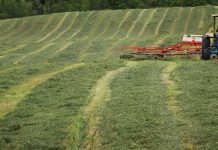By Chris Zoller and Mike Estadt
Each month, the U.S. Department of Agriculture Economic Research Service publishes the Livestock, Dairy and Poultry Outlook. Each report analyzes the economic impacts of month-to-month changes in USDA’s WASDE reports. This article will review the dairy section of the report and provide management suggestions to consider.
The Dairy Margin Coverage Program was authorized in the 2018 Farm Bill to offer protection to producers when the difference in the national all-milk price and the national average feed price falls below the producer-selected margin. Reduced milk prices and increased feed costs resulted in the margin calculated for the Dairy Margin Coverage program to decline $4.83 in May, $7.68 lower than in May 2022. This is the lowest dairy farm margin so far in 2023.
The Class III milk price is projected at $16.05 per hundredweight because of expected lower prices for cheese and dry whey. This represents a reduction of $.65 from the forecast last month. Class IV and the all-milk price are projected down compared to the previous month’s forecast. Class IV is forecast at $18.20 per hundredweight and the all-milk price for 2023 is at $19.55 per hundredweight.
Unfortunately, price projections for 2024 are expected to drop compared to 2023. The Class III milk price is forecast at $15.95 per hundredweight. Class IV is expected to be $17.45 and the all-milk price for 2024 is $19.10.
If these forecasts hold true, 2024 will be another challenging year in the dairy business. When dairy farm margins decrease, it means that the profitability of the farm is shrinking and the costs of production may exceed the revenue generated from milk sales. In such situations, dairy farm management needs to take prompt and strategic actions to improve profitability and ensure the sustainability of the operation.
What can you do to prepare? The following suggestions are modified from an article we wrote a few months ago for the OSU Extension Ohio Ag Manager newsletter. When developing a plan, consider the following suggestions:
Know your cost of production. Decision-making is much easier when this is known.
Review and adjust your budget. Take a close look at your financial situation and revise your budget to align with the projected reduced income. Identify where costs can be cut without compromising the health of the cows or the quality of the milk. This might be optimizing feed management, improving labor efficiency and exploring energy-saving technologies.
Manage risk effectively. Given the uncertain agricultural market conditions, it’s crucial to have risk management strategies in place. Explore options such as crop insurance, futures and options contracts, or other risk management tools that can provide some protection against price volatility or unexpected events.
Diversify your income streams. Explore opportunities to diversify your income by expanding into complementary agricultural activities or exploring non-farm ventures. For example, you could consider value-added processing, agritourism or direct marketing to consumers.
Improve operational efficiency. Look for ways to enhance productivity and reduce waste on your farm. Implement efficient farming practices, optimize resource allocation and consider adopting technologies that can streamline operations and reduce costs.
Improve cow health and welfare. Healthy cows are more productive and efficient, leading to better margins. Focus on proper nutrition, disease prevention and overall cow welfare.
Seek additional education. Stay informed about market trends, agricultural policies and technological advancements. Attend workshops, webinars or conferences to learn about best practices and access resources to help you navigate challenging times.
Collaborate. Engage with local agricultural organizations, OSU Extension or farmer networks to share knowledge, resources and experiences. Collaborative efforts can help reduce costs through group purchasing, shared equipment or joint marketing initiatives.
Explore assistance programs. Stay updated on government programs and initiatives that provide financial assistance or support to farmers during challenging times.
Monitor and adapt. Regularly monitor your financial performance, market conditions and emerging trends. Be prepared to adapt your strategies as needed to navigate changing circumstances and take advantage of new opportunities.
When planning, we suggest involving family and trusted advisors to help navigate the process of moving your farm forward. Ultimately, dairy farm management should continuously monitor financial performance, adapt to market conditions and be proactive in implementing measures to navigate through periods of reduced margins. Flexibility and innovation are essential qualities in ensuring the long-term success of a dairy farm.
(Chris Zoller is an agricultural extension educator and county Extension director in Tuscarawas County. Mike Estadt is an agricultural extension educator in Pickaway County.)













